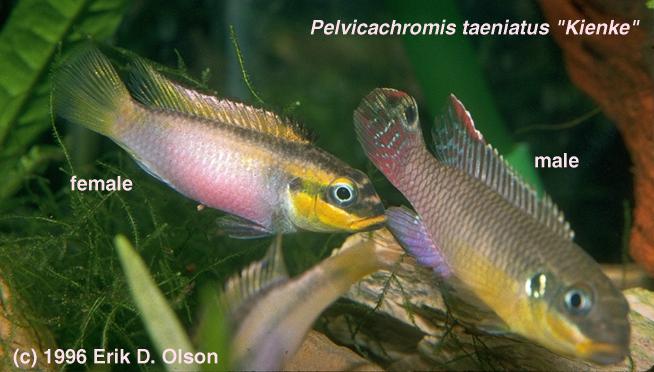
Promising myself I wouldn’t buy any fish, I kept looking at all the
incredible Pelvicachromis I was running across. First, I died
when I saw the P. humilis Nigerian Red
. Then it was
P. taeniatus. Now, P. taeniatus is a group all its own,
having over a dozen color forms. Tracking off to the Cichlid Exchange
in Portland, Oregon, I quickly fell in love with P. taeniatus
Moliwe
and Lobe
; the color on these guys is phenomenal,
especially the female. I decided I would have to one day purchase one
of these cool fish. Though I resigned myself to waiting, fate intruded
and at the ACA auction I discovered yet another great form of
P. taeniatus: Kienke
. I purchased five, two males and three
females, for an incredible price, and brought them home for my
30-gallon long tank. Being wild-caught, they were quite beat-up, but
the females colored up beautifully: purple and yellow, with a black
eye band. The males were in sadder shape, missing their tails; yet
that didn’t stop them from quickly taking over the whole tank. Within
24 hours, the dominant male was beating up the other four in the tank,
after 3 days one female and one male wouldn’t leave the top corner,
while the rabid dominant male ferociously chased the other two
females. At this point I could easily see losing all except the one
ornery male. So I removed the most beat-up pair, put them in a 20 with
some dithers. The first day, I thought this might work; the new pair
seemed to gain confidence. Then the once-submissive male reverted to
his savage nature. On day two he took to beating the female up. On day
three, he kept her confined to the upper 1/2 inch of the tank; now she
wouldn’t even eat. In the meantime, with two less Kienke targets, the
dominant male even more aggressively attacked the remaining two
females.
Being exasperated at this point, I decided screw the males
, and
put them in a divided 10-gallon tank (with dithers, of course). They
quickly lost color and hid out. I returned the lone female to the
other two in the 30; they quickly colored up and divided the tank into
thirds. I left things like this for a few weeks, and in the meantime
marveled at the P. taeniatus in the local store. The owner was
peacefully keeping a pair of Nigerian Green
in a 10, 2-3 pairs of
Bandawouri
in a 20, and 2-3 pairs of huge Muyuka
in a
20. Well, I guess I got the aggressive color form! Or perhaps they
were trying to keep an area comparable to their wild territory.
After several weeks I decided return the dominant male to the 30
and its three females. He quickly reverted to his bastard
self and
tried beating up the females. However, they now responded to him in a
new way...they tried the spawning dance. Intimidation definitely did
not work. Gradually they reached a status quo with the male keeping
his territory overlapping with the three dancing females. He colored
up beautifully with yellow lips and red-edged fins. The females were
patterned beautifully in purple, yellow and black.
Now, the remaining male, solo in the 10, was looking quite forlorn. After letting him be for several weeks, I decided to move one of the females. Mistake! In three days her fins were shredded and she remained at the top of the tank, practically 1/2 out of the water. So I moved her back to the 30. Mistake! I should have never moved her out; by now the other two females had taken over her territory and the male saw her as a foreigner. Everyone beat her up and she certainly forgot her dance with the male, so he proceeded to hunt her down. At this point, I figured I had killed her, and I chalked it up to experience. So I went on call at the hospital and ignored my tanks for a few days. When I finally looked, all had worked out well. She had survived (albeit rather beat-up) and gradually regained her old territory, but still had not reached her old position yet. All the females color up beautifully and dance with the male, but as of yet no one has spawned. I can only hope.
The Kienke’s were much more aggressive than I had ever expected, certainly when compared with the other color forms. One can only speculate why.
If I had a bigger tank, perhaps it would have helped. I certainly wouldn’t put them in anything smaller.
Now as I approach a massive fish move, I wonder what will happen to
the Killer Kienke’s.
Stay tuned.
Kathy Knudsen Keeps Kribs (and Krib Kids), Kienke’s, and a Kat. She’s also the GSAS FAAS rep, but I can’t make that start with K
.